In today’s interconnected world, convenience is abundant, and gratification is instant. However, that interconnectivity has also opened the floodgates for global-scale cybercrime. According to the FBI’s 2023 Internet Crime Report, reported cybercrime losses in the U.S. exceeded $12.5 billion. A separate study by Gigamon estimates that 33% of breaches go undetected. According to Bromium’s 2018 Into the Web of Profit study, the global cybercrime economy generates about $1.5 trillion in annual criminal revenue, i.e., money flowing to criminals, not counting victim losses. For global victim/economic losses, CSIS/McAfee estimated roughly $1 trillion in 2020.
According to LexisNexis Risk Solutions, financial institutions worldwide spent approximately $206.1 billion on financial crime compliance in 2023. U.S. institutions with assets exceeding $10 billion averaged $27.8 million in annual compliance costs in 2021, and 70% of EMEA institutions reported rising technology/KYC software costs. Yet, the security tools we have been relying on amount to bringing a knife to a gunfight. These older methods, typically built on relational databases and models that rely on historical data, usually lack the speed, flexibility, and comprehensive view needed to uncover the intricate, multi-layered patterns that modern attackers employ.
Here’s where things get interesting: graphs are revolutionizing the game. Instead of looking at data in contextless, siloed table structures, graph models view everything as one big, connected asset. They can instantly identify how users, accounts, devices, and transactions are all interconnected because complex relationships are inherent to the graph. Case studies report that graph-based features helped Intuit detect nearly 50% more risk events with 50% better precision, and a separate deployment at Danske Bank cut false positives by nearly 60% while boosting true-fraud detection by as much as 50%. What used to take hours, or even days, to uncover — such as complex money laundering schemes or fraud networks — now occurs in milliseconds.
It is no surprise, then, that the graph market has experienced explosive growth, with widespread enterprise adoption and continuous innovation, in recent years. According to Fortune Business Insights, the global graph database market is projected to grow from $2.85 billion in 2025 to $15.32 billion by 2032, at a CAGR of 27.13%.
The true power of graphs is further amplified when integrated with advanced artificial intelligence. In their paper “Improving Network Threat Detection by Knowledge Graph, Large Language Model, and Imbalanced Learning“, Zhang et al propose a multi-agent AI framework that combines a Knowledge Graph (KG), an Imbalanced Learning Model (ILM), and a Large Language Model (LLM). The KG analyzes user activity patterns and identifies the risks associated with unknown threats. The ILM detects rare malicious events through a specialized AI technique that handles datasets where one class (such as fraud) is rare compared to another (such as everyday transactions). Standard models naturally show bias toward the majority class, which causes them to miss rare but important cases. The ILM technique intentionally creates a counter-bias toward the minority class to catch those critical, rare events, like fraud. The LLM then acts as a query-and-reasoning engine, translating user questions into graph queries, retrieving and interpreting these risks from the KG and ILM, and providing human-readable explanations of anomalies. It can even generate multi-step attack templates to predict complex Advanced Persistent Threat (APT) behaviors. This approach has been shown to improve threat capture rates by 3%-4% (worth nearly $500 million in 2023 alone) and adds crucial natural language interpretations to risk predictions, thereby increasing human response times.
At Rocketgraph, we are already making this a reality. Our system delves deep into connections without requiring any starting points (seedless traversal). Our GenAI interface enables security analysts to ask questions in natural language with a minimal learning curve. For Zero-Day attacks, for example, Rocketgraph unifies endpoint, identity, and network telemetry into a live attack graph, surfacing abnormal privilege chains and lateral movement at first touch, which helps deliver time‑to‑detect zero‑day exploitation in minutes, not hours.
The bottom line? Instead of treating every piece of data like it exists in a vacuum, we’re finally looking at the big picture. This approach is helping security teams catch the bad guys in real-time and stay one step ahead of an increasingly clever and pesky group of cybercriminals.




